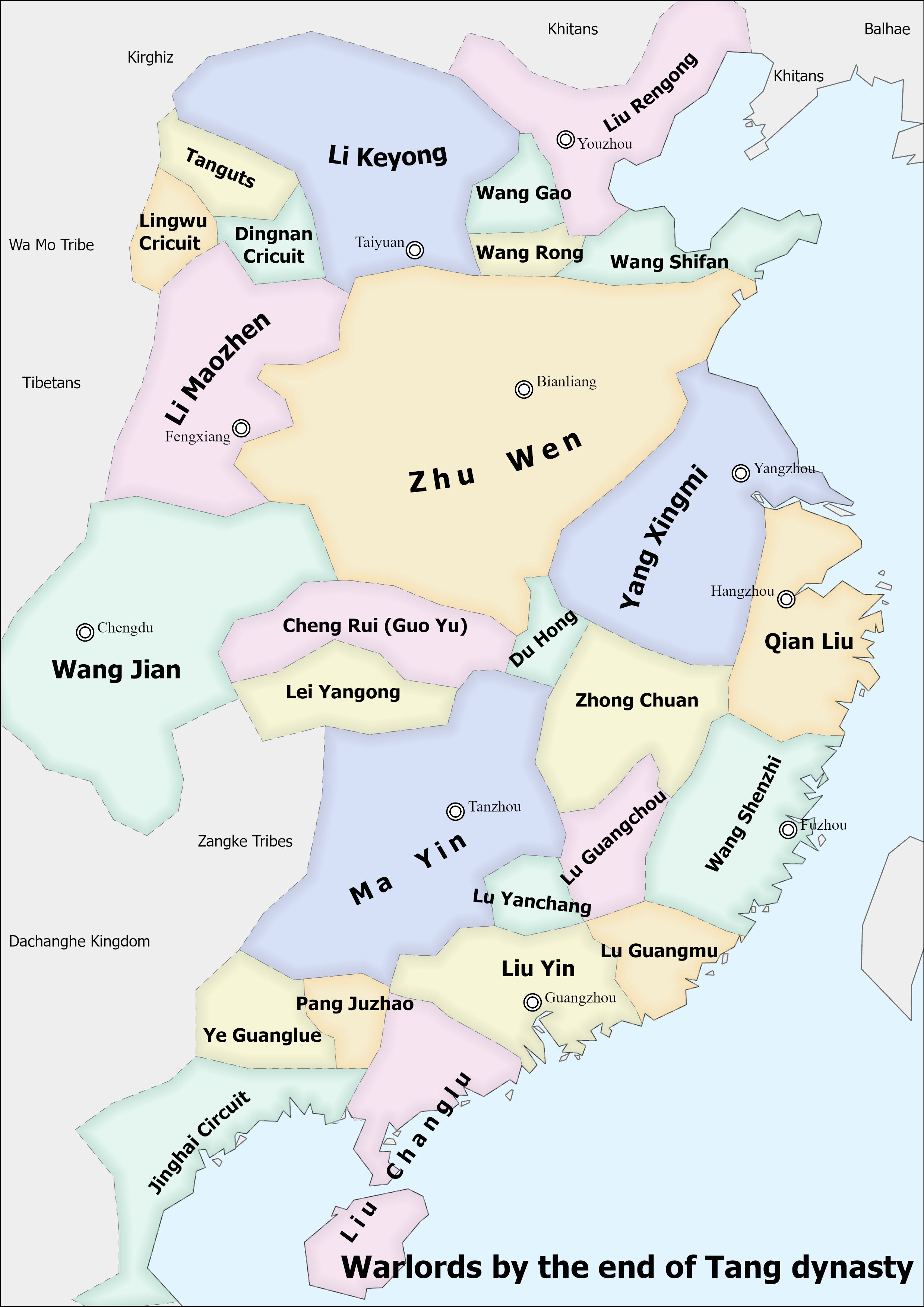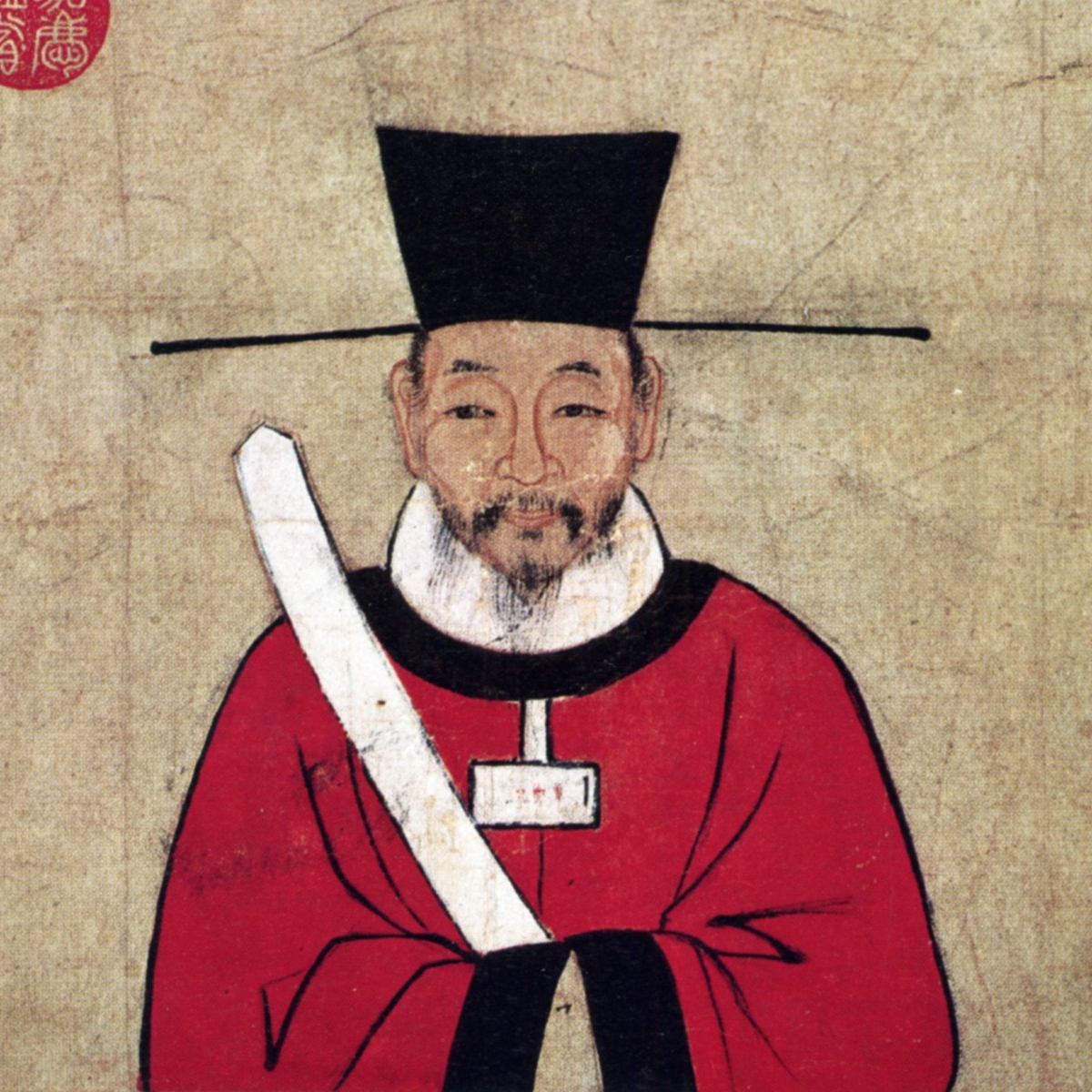|
Cheng Rui
Cheng Rui (µłÉµ▒Ł died June 10, 903''Zizhi Tongjian'', vol. 264.Academia Sinicabr>Chinese-Western Calendar Converter), adoptive name Guo Yu (ķāŁń”╣ used until c. 888), formally the Prince of Shanggu (õĖŖĶ░ĘńÄŗ), was a warlord late in the Chinese Tang dynasty who ruled Jingnan Circuit (ĶŹŖÕŹŚ headquartered in modern Jingzhou, Hubei) from 888 to 903, until he was defeated in battle. He was known to be a capable administrator who treated his people well. Background It is not known when Cheng Rui was born, but it is known that he was from Qing Prefecture (ķØÆÕĘ×, in modern Weifang, Shandong). In his youth, he had once killed another person when drunk, and thereafter fled from his home prefecture in order to avoid vengeance. He became a Buddhist monk for a while, but later joined as a soldier under Tang rebel general Qin Zongquan at Cai Prefecture (ĶöĪÕĘ×, in modern Zhumadian, Henan). He was adopted by one of Qin's generals and thereafter changed his name to Guo Yu.''New Boo ... [...More Info...] [...Related Items...] OR: [Wikipedia] [Google] [Baidu] |
Zizhi Tongjian
The ''Zizhi Tongjian'' (1084) is a chronicle published during the Northern Song dynasty (960ŌĆō1127) that provides a record of Chinese history from 403 BC to 959 AD, covering 16 dynasties and spanning almost 1400 years. The main text is arranged into 294 scrolls (), each equivalent to a chapterŌĆötotaling around 3 million Chinese characters. In 1065, Emperor Yingzong of Song commissioned his official, Sima Guang (1019ŌĆō1086), to lead a project to compile a Universal history (genre), universal history of China, and granted him funding and the authority to appoint his own staff. His team took 19 years to complete the work and in 1084 it was presented to Emperor Yingzong's successor Emperor Shenzong of Song. It was well-received and has proved to be immensely influential among both scholars and the general public. Endymion Wilkinson regards it as reference quality: "It had an enormous influence on later Chinese historical writing, either directly or through its many a ... [...More Info...] [...Related Items...] OR: [Wikipedia] [Google] [Baidu] |
Chen Ru
Chen Ru (’╝ød. 885) was a warlord late in the Chinese Tang dynasty, who ruled Jingnan Circuit (ĶŹŖÕŹŚ modern Jingzhou, Hubei) from 882 to 885, most of that time as its military governor (''jiedushi''). Background It is not known when Chen Ru was born, but it is known that he was from Jingnan Circuit's capital Jiangling Municipality and that his ancestors had served for generations as army officers.''New Book of Tang'', vol. 186. As of 882, the military governor of Jingnan, Duan Yanmo, had an adversarial relationship with the eunuch monitor of the Jingnan army, Zhu Jingmei. Zhu selected 3,000 elite soldiers and called them the Zhongyong Army, putting it under his own command. Duan, in anger, decided that he wanted to kill Zhu. However, Zhu took preemptive action in summer 882 and attacked Duan, killing him. Zhu initially made the deputy mayor of Jiangling, Li Sui (), acting military governor. Then-reigning Emperor Xizong commissioned a former military governor of Jingnan, Zhe ... [...More Info...] [...Related Items...] OR: [Wikipedia] [Google] [Baidu] |
Chancellor Of Tang Dynasty
The chancellor () was a semi-formally designated office position for a number of high-level officials at one time during the Tang dynasty of China. This list also includes chancellors of the short-lived Wu Zhou dynasty, which is typically treated as an interregnum of the Tang dynasty by historians. Origins Ouyang Xiu, the author of the ''New Book of Tang'', asserts that the Tang dynasty inherited its bureaucracy from its dynastic predecessor, the Sui dynasty, under which the founder Emperor Wen of Sui divided his government into five main bureaus: * ''Sh├Āng sh┼½ sh─øng'' () ŌĆō The Department of State Affairs * ''M├®n xi├Ā sh─øng'' () ŌĆō The Chancellery * ''N├©i shŪÉ sh─øng'' () ŌĆō The Legislative Bureau (note different tone than the eunuch bureau below) * ''M├¼ sh┼½ sh─øng'' () ŌĆō The Palace Library * ''N├©i sh├¼ sh─øng'' () ŌĆō The Eunuch bureau (note different tone than the legislative bureau above), later changed by Emperor Wen's son Emperor Yang of Sui to ''Di├Ā ... [...More Info...] [...Related Items...] OR: [Wikipedia] [Google] [Baidu] |
Shaanxi
Shaanxi is a Provinces of China, province in north Northwestern China. It borders the province-level divisions of Inner Mongolia to the north; Shanxi and Henan to the east; Hubei, Chongqing, and Sichuan to the south; and Gansu and Ningxia to the west. Shaanxi covers an area of over with about 37 million people, the 16th-largest in China. Xi'anwhich includes the sites of the former capitals Fenghao and Chang'anis the provincial capital and largest city in Northwest China and also one of the oldest cities in China and the oldest of the Historical capitals of China, Four Ancient Capitals, being the capital for the Western Zhou, Western Han, Sima Jin, Jin, Sui dynasty, Sui and Tang dynasty, Tang List of Chinese dynasties, dynasties. Xianyang, which served as the capital of the Qin dynasty (221ŌĆō206 BC), is just north across the Wei River. The other Prefectures of China, prefecture-level prefecture-level city, cities into which the province is divided are Ankang, Baoji, Hanzho ... [...More Info...] [...Related Items...] OR: [Wikipedia] [Google] [Baidu] |
Weinan
Weinan ( zh, s=µĖŁÕŹŚ , p=W├©in├Īn) is a prefecture-level city in east-Guanzhong, central Shaanxi, Shaanxi province, northwest China. The city lies on the lower section of the Wei River confluence into the Yellow River, about east of the provincial capital Xi'an, and borders the provinces of Shanxi and Henan to the east. The name "Weinan", literally meaning "south of the Wei River", describes the location of the city's urban area, urban district (China), districts being mostly south of the Wei River, although majority of its metropolitan area actually lies on the north side of the river. History As a significant area between the ancient Chinese capital Xi'an and Luoyang, Weinan has a long history. Ancient The ancient Dali (fossil), Dali Man lived in the modern area of Weinan. The Xiagui county was settled in the year of 668 BC by the state of Qin (state), Qin. Weinan got its name in the year of 360 by the Former Qin state. In the Tang dynasty, 10 List of emperors of the Tang ... [...More Info...] [...Related Items...] OR: [Wikipedia] [Google] [Baidu] |
Han Jian (Zhenguo Warlord)
Han Jian (ķ¤ōÕ╗║) (855'' History of the Five Dynasties'', vol. 15.-August 15, 912Academia Sinicabr>Chinese-Western Calendar Converter''Zizhi Tongjian'', vol. 268.), courtesy name Zuoshi (õĮɵÖé), was a warlord late in the Chinese Tang dynasty, who eventually became a subject of the succeeding Later Liang state. He is most well known for having had Emperor Zhaozong of Tang under his control at his power base at Hua Prefecture (ĶÅ»ÕĘ×, in modern Weinan, Shaanxi) from 896 to 898 and slaughtering the imperial princes while Emperor Zhaozong was there. During Tang dynasty Background and early career Han Jian was born in 855, during the reign of Emperor Xu─ünzong of Tang. He was from Xu Prefecture (Ķ©▒ÕĘ×, in modern Xuchang, Henan). His ancestors, including his father Han Shufeng (), had served for generations in the army. When Qin Zongquan took over Cai Prefecture (ĶöĪÕĘ×, in modern Zhumadian, Henan) in 880,''Zizhi Tongjian'', vol. 254. he encouraged people to join his arm ... [...More Info...] [...Related Items...] OR: [Wikipedia] [Google] [Baidu] |
Emperor Zhaozong Of Tang
Emperor Zhaozong of Tang (March 31, 867 ŌĆō September 22, 904), n├® Li Jie, name later changed to Li Min and again to Li Ye, was the penultimate emperor of China's Tang dynasty. He reigned from 888 to 904 (although he was briefly deposed by the eunuch Liu Jishu in 900 and restored in 901). Emperor Zhaozong was the seventh son of Emperor Yizong and younger brother of Emperor Xizong. Later, Li Jie was murdered by Zhu Wen, who would later become the founding emperor of the Later Liang dynasty. During Emperor Zhaozong's reign, the Tang dynasty fell into total disarray and rebellions, which had been ongoing since the reign of his older brother, Emperor Xizong, as they erupted throughout the country while the imperial government's authority effectively disappeared. In the midst of all this, Emperor Zhaozong tried to salvage the dying dynasty. However, his efforts to reassert imperial power generally backfired, as his unsuccessful campaigns against Li Keyong, Chen Jingxuan, and ... [...More Info...] [...Related Items...] OR: [Wikipedia] [Google] [Baidu] |
Chongqing
ChongqingPostal Romanization, Previously romanized as Chungking ();. is a direct-administered municipality in Southwestern China. Chongqing is one of the four direct-administered municipalities under the State Council of the People's Republic of China, Central People's Government, along with Beijing, Shanghai, and Tianjin. It is the only directly administrated municipality located deep inland. The municipality covers a large geographical area roughly the size of Austria, which includes several disjunct urban areas in addition to Chongqing proper. Due to its classification, the municipality of Chongqing is the List of largest cities, largest city proper in the world by population, though Chongqing is not the most populous urban area. The municipality of Chongqing is the only Chinese city with a resident population of over 30 million; however, this number includes its large rural population. In 2020, Chongqing surpassed Shanghai as China's largest municipality by urban populati ... [...More Info...] [...Related Items...] OR: [Wikipedia] [Google] [Baidu] |
Wang Jianzhao
Wang Jianzhao (ńÄŗÕ╗║Ķéć) was a warlord late in the Chinese Tang dynasty, who controlled Jingnan Circuit (ĶŹŖÕŹŚ, headquartered in modern Jingzhou, Hubei) from 887 to 888, and then Wutai Circuit (µŁ”µ│░, headquartered in modern Chongqing) from 888 to 896, when he surrendered to Wang Jian. Background and control of Jingnan Little is known about Wang Jianzhao's background, as there was no biography for him in any of the official histories. The first historical reference to him was in 887, as of which time he was serving under Zhao Deyin, who had then claimed the title of acting military governor of Shannan East Circuit (Õ▒▒ÕŹŚµØ▒ķüō, headquartered in modern Xiangyang, Hubei) under allegiance to Qin ZongquanŌĆöwho was formerly a Tang general but who had rebelled against the rule of Emperor Xizong and claimed the title of emperor himself at Cai Prefecture (ĶöĪÕĘ×, in modern Zhumadian, Henan). Late in 887, Zhao attacked Tang's Jingnan Circuit and killed its military governor (''jied ... [...More Info...] [...Related Items...] OR: [Wikipedia] [Google] [Baidu] |
Zhao Deyin
Zhao Deyin () (died 892), formally the Prince of Huai'an (), was a warlord late in the History of China, Chinese dynasty Tang dynasty, who initially served as a general under the pretender emperor Qin Zongquan. When Qin neared defeat, Zhao declared loyalty to Tang instead, and was able to retain control of Zhongyi Circuit (Õ┐ĀńŠ®, headquartered in modern Xiangyang, Hubei), which, after his death, was passed to his son Zhao Kuangning. Background and service under Qin Zongquan It is not known when Zhao Deyin was born. His family was from Cai Prefecture (ĶöĪÕĘ×, in modern Zhumadian, Henan). At some point, he became an officer under Qin Zongquan, who was then the Tang dynasty, Tang military governor (''Jiedushi'') of Fengguo Circuit (ÕźēÕ£ŗ, headquartered at Cai Prefecture). When Qin was involved in the Tang forces' campaigns against the major agrarian rebel Huang Chao, Zhao had battlefield accomplishments and was rewarded by being made the prefect of Shen Prefecture (ńö│ÕĘ×, in mo ... [...More Info...] [...Related Items...] OR: [Wikipedia] [Google] [Baidu] |



